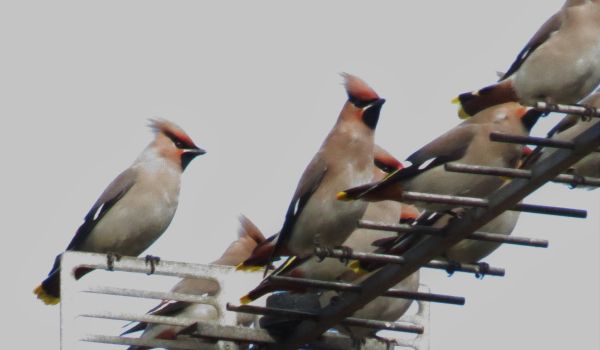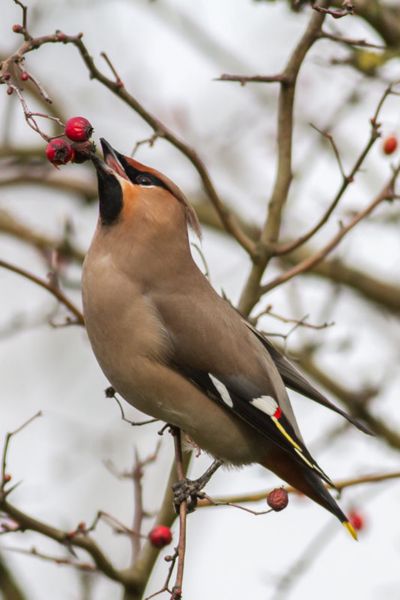Nature Note – Waxwing Encounters

Waxwings have featured in a previous Nature Note. From time to time a successful breeding season coincides with a poor crop of seeds and berries. The consequence is that large numbers of birds leave their forests in northern Europe and head south to seek food in non-traditional areas. If such an irruption occurs at the same time as a period of easterly winds, large numbers of birds reach the UK. These become known as ‘Waxwing Winters’ and following a gap of several years 2023-2024 is such a winter.
Since mid-October, birds have been arriving in numbers in Scotland and north-east England. Flocks of 100 plus birds have been recorded from multiple sites. As the winter progresses these birds will exhaust the food supplies in the north and spread south and west. Individuals and small groups have already been recorded in Leicestershire; by Christmas, Wiltshire was the only English county not to have been visited. Flocks will almost certainly be with us early in the New Year.
The national press tends to refer to Waxwings as ‘supermarket car park dwellers’. It is true that the berry bearing shrubs and trees planted around supermarkets and alongside busy roads provide an important food resource. However, any tree or shrub with a good crop of berries can attract these birds. Seen at close quarters, Waxwings are unmistakable, but a flock in the top of a tree might at first sight be passed off as a group of Starlings. The time has come to start looking more closely at any ‘Starlings’ that you see.

All sightings of Waxwings are memorable. Flocks often occur in urban areas and the birds can be approachable and easy to photograph. Over the years I have had some especially memorable encounters, including:
- A small party of exotic looking birds appearing outside my student residence in the 1960’s. With no internet in those days, a trip to the library was necessary before I could put a name to what I had seen. A few days later, The Yorkshire Post, ran an article about flocks of these unusual birds being widely reported around the Leeds area.
- In February 1996 an enormous flock estimated at 300+ birds turned up in Nottingham. Then someone noticed that the flock had been joined by a closely related, Cedar Waxwing, from North America. Large numbers of “birders” became involved in a “Where’s Wally” exercise. Most of us eventually got to see the American bird.
- In 2019 a single bird found a berry tree in Wellington Street, Leicester. This bird was oblivious to large numbers of pedestrians walking just a few feet below where it was feeding. Some of the passers-by were in too much of a rush to notice the bird or the berries on the tree.
- Three birds in Church Langton in 2017 deserve a mention as the closest to Kibworth that I have seen Waxwings. Hopefully, this winter, someone will find a flock in Kibworth, or better still, my garden might be visited.
Most of the birds that I have seen have been in built-up areas. At one time bird watchers were very self-conscious about wandering around towns with cameras and binoculars. Nowadays, “the public” soon become aware that something special is happening and are often keen to tell you when they first saw the birds and what the birds are up to. If the birds are not giving close-up views, passers-by are only too pleased to be offered a look through a telescope.
As a rule, birdwatchers enjoy promoting birds. Whenever you come across a group of people with telescopes and cameras feel free to ask what they are looking at. Someone will soon offer you a telescope view. In the next few months, what they are watching may well be a flock of Waxwings.
David Scott




 Kaye Angus Accupunturist
Kaye Angus Accupunturist

